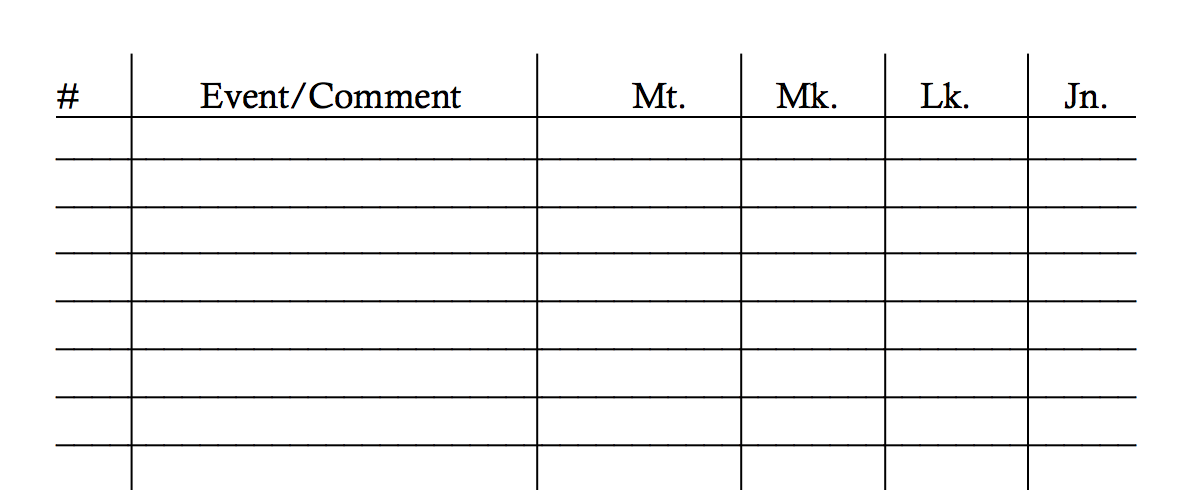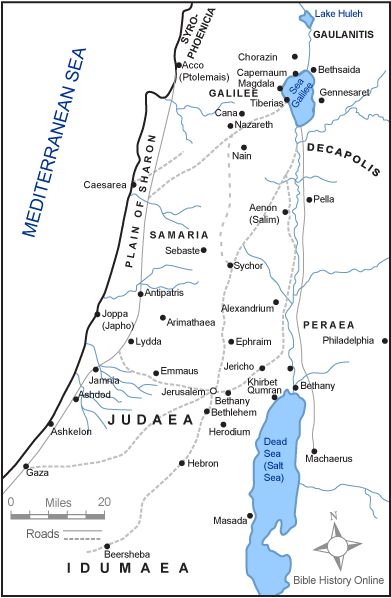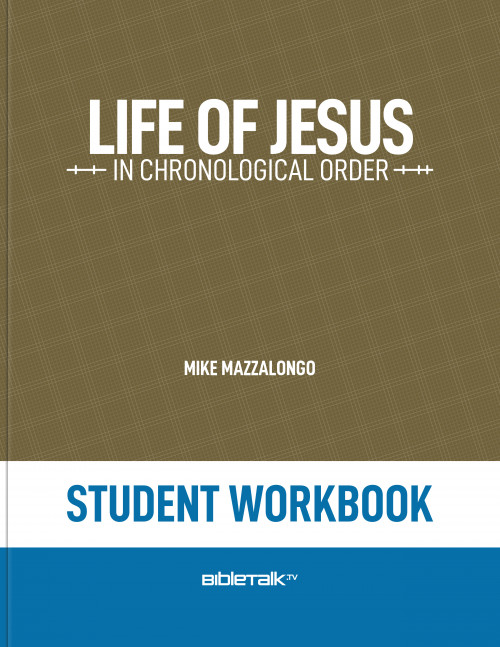Introduction to the Life of Jesus
One of the more popular forms of books has been the biography of famous people. We love to read about the intimate details and early lives of the rich and famous or those who have made significant contributions to society. It seems that by reading about their lives, we measure our own. Many times we are inspired to change or try things because of the example of another. Biographies also give us insights into the forces and events that shaped the person and help us understand the world of the past and also how these influences shape our own lives. It would seem natural then that studying the life of Jesus would benefit us in all of these ways and also help establish a true standard for living since we are looking at the life of the Son of God.
Usually when we study the gospels, we are looking at the teachings of Jesus and what they mean and how they can be applied in our lives. We rarely study Jesus Himself, His life in the order He lived it. The reason for this is because the gospel writers each record a variety of incidents in Jesus' life not recorded by the others. So when you read the 4 gospels, one after another, you're not always sure how the events flow. They each tell the story from His birth to His death, but the details in between are not always explained in chronological order so you can get a sense of how one event leads to another.
This book therefore will have several objectives:
- I will present to you the life of Jesus in chronological order. What He did and where He went from first to last in a step-by-step description.
- Help you prepare a notebook where you will have:
- The events in Jesus' life listed in order.
- Parallel scriptural references for these events also listed in chronological order.
- For this I would ask you to get a notebook, preferably one that will hold 8½X11 paper (ring binder).
- For example your notes will look like this:

By the end of this course you will have a notebook with a complete biography of Jesus' life, ministry, miracles, and passion all listed in chronological order.
Jesus' Ministry
When Jesus was born the world kept time according to the Roman calendar. The Roman calendar was based on the year that the city of Rome was founded. With this calculation, Jesus was born in the year 753 because the city of Rome was said to have been founded 753 years previous to the year of His birth, so if we kept with this calendar we'd be in the year 2746 Roman time as of the year 2014.
Some people of that era kept time according to the years a certain king or emperor was in power (Luke 3:1), John's ministry is said to begin in the 15th year of the reign of Tiberius Caesar.
In the Middle Ages the Christian calendar was introduced using the birth of Jesus as the zero point. When calculations were made and calendars produced and distributed it was noted that an error was made and that the date of Jesus' birth was approximately 4 years before the zero date they had previously calculated. Since all had been done, they left it alone. This is how it came to be that when pinpointing the calendar date of Jesus' birth, scholars tell us that He was born in 4 BC!
We also know that He died when He was 33. Luke 3:23 says He was 30 years of age when He began His ministry. When you review His ministry event by event you see that He lived through 3 annual Passover celebrations and died during the celebration of the 4th.
If He was born around 4 BC and died at 33, it means the calendar date of His death is approximately 29 AD – so Pentecost happened in 29 AD. Those churches whose cornerstone says, "This church established in 33 AD" have the right doctrine and spirit, but they have the wrong date.
Even by New Testament standards, 33 was still young to die. The normal life span was about 50-55 years at that time. When studying Jesus' life we can divide it into 7 main periods:
1. Jesus' Boyhood – 0-12 years
These include incidents and prophecies that led to His birth and the little information we have about His childhood.
There have been many books written about this time that show Jesus doing miracles (stretching lumber for Joseph) or living with the desert monks (Essenes) where He was trained, but these are based on fables and stories circulated about His life in the early years. The only information God has revealed about His childhood is limited and contained in a few passages of Matthew and Luke.
2. Inauguration of Jesus' Public Ministry
At the age of thirty, Jesus leaves His obscure life in Nazareth and Capernaum in the northern region and travels south to begin His public ministry. This debut is spectacular and includes His meeting with John the Baptist.
3. Public Ministry of Jesus from 1st to 2nd Passover
Most of the information for this period is found in the book of John. Jesus performs most of His ministry in Jerusalem and departs for the north.
4. Public Ministry of Jesus from 2nd to 3rd Passover
Thirty six events make up this section where most of the action takes place in Galilee, the northern part of the country where Jesus originally grew up.
5. Ministry from the 3rd Passover to the Beginning of the Last Passover Week

This is the longest section in the New Testament. There are 61 events mentioned in this period and all 4 writers describe these in detail. During this time we see Jesus going back and forth from the north, northwest to the southern capital of Jerusalem.
This section also describes some of the stays along the way where Jesus carried out His ministry walking to and fro with disciples accompanying Him on the road.
6. Last Passover Week Ending with Crucifixion
We will go through this section giving you the events day by day as they took place. According to our present day calendars, it would have been Sunday, April 2 ndto Saturday, April 7th, His final day in the tomb.
7. Resurrection, Appearances and Ascension
Aside from His ascension before the Apostles, the Bible counts 10 separate appearances to more than 540 people in a space of 40 days. We will go over these in our study.
Hopefully at the end of our study the ministry of Jesus, His life and His work will become more real, more understandable as a historical event and not simply a string of teachings gathered together in 4 books.
In each chapter I'll try to focus in on some event or teaching to draw a lesson or share a word of encouragement.
Lessons
In this chapter we've not looked at any one event, but rather an overview of Jesus' movements and work. However, even this brief review provides several important lessons:
1. There was a Method
When you read the gospels you don't readily see the pattern of His movements, but there definitely was a well-laid plan.
- Early years at home with family.
- The announcement of His ministry in the southern capital where John was, along with the Jewish leaders and the bulk of the population.
- Return to the north to actually begin His teaching and miracles for His own family, recruiting His own neighbors as disciples.
- Returning to Jerusalem to expand His ministry once it was established.
- Spending time in the north and after being rejected and hunted by leaders in the capital.
- Final appearance in Jerusalem which resulted in His death and resurrection. Church begins in Jerusalem and spreads out.
2. Movements Based on Prophecy
The fact that He was born in Bethlehem and raised in Nazareth were mentioned in the prophets (Micah 5:2; Matthew 2:23 respectively).
Jesus Himself mentioned that He did the will of the Father. The Holy Spirit moved Him to go into the desert to be tempted. He did not go to Jerusalem until the "time" was fulfilled.
So we don't see mindless wandering, but rather a well ordered ministry timed to be in certain places at certain periods based on God's word in the prophets and His will during the period Jesus was physically on earth.
3. Small Area – Great Impact
Jesus covered a corridor roughly 100 miles long and 60 miles wide in His 3 year ministry. Look at the impact over 2,000 years later. When we are thinking we can't do much for Christ from our little town or our small resources, remember how much came from so little.
If God directs our work and efforts, we can affect the world for Christ from right where we live.
READING ASSIGNMENT FOR CHAPTER 2
Discussion Questions
- Why is it important to study the life of Jesus as well as His teachings? Discuss why it is important to distinguish between the popular stories and the reality of the scriptures.
- Imagine you are in the time period of the life of Jesus and you hear of a man claiming to be the Messiah. What questions would you have that would help you determine the truth of His claims? How do these differ today as we hear about Jesus as our Savior?
- Why did the gospel writers include details such as names, dates and events in their records?
- Why would the gospel writers not include details of the early life of Jesus' boyhood and what is the value of this to us?
- Without reviewing the text, state as many of the 7 major divisions in the life of Jesus as you can.
- How can you use this lesson to grow spiritually and help others come into a relationship with Jesus?




